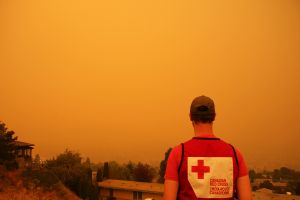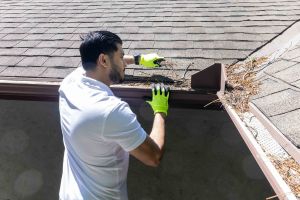A very real threat, not to be underestimated
Every year in Canada, wildfires are becoming more and more intense, frequent, and unpredictable. Even when temperatures seem mild, danger can strike at any moment. Climate change is adding fuel to the fire, making our living environments more vulnerable.
Credit: Angela Hill / Canadian Red Cross
That’s why it’s important to be well prepared before an emergency happens. Planning ahead means keeping not only yourself safe, but also your loved ones and your community.
Preventing fires, one step at a time
You can’t control everything, but you can dramatically reduce risks by being more self-sufficient in the event of an emergency. Here are some good steps to take:- Fully switch off and put out any outdoor sources of fire after use (barbecues, fire pits, etc.).
- Never throw cigarette butts on the ground, especially not in a forested area or on the side of the road.
- Clean your gutters and remove dead leaves from around your house.
- Store propane cylinders away from buildings.
- Keep a hose accessible when it’s hot out.

Credit: John Falcon / Canadian Red Cross
Share these practices with your loved ones to become a true fire safety ambassador!
Developing a personal emergency plan: your greatest ally
In the event of an evacuation, every minute counts. Having a detailed and well-developed emergency plan can make all the difference. It helps you keep your cool and respond effectively, even under stress or confusion. 
Credit: Aldis Brennan / Croix-Rouge canadienne
Some things your plan should include:
- An evacuation route and plan B.
- A meeting place outside your neighbourhood that everyone knows.
- A list of emergency contacts (family, neighbours, doctor, etc.).
- A grab-and-go emergency kit.
- A plan for your pets, if you have any.
Your emergency kit: a must-have
Get an emergency kit to ensure that you have the essentials to handle the situation. The kit should have enough to last you three days on your own, in case emergency services are delayed. In remote and/or northern communities, it’s best to have enough essentials to last you more than three days, if possible. Your kit should include:
- Water (two litres per person per day)
- Non-perishable food
- Flashlight and batteries
- Crank or battery-operated radio
- Essential medications
- Copies of your important documents
- First aid kit
- Change of clothes and personal hygiene items
Don’t wait until a crisis to act
Being prepared isn’t being over the top—it’s being practical. It gives you peace of mind, makes you more self-sufficient, and allows you to be a pillar of support for others.So, why wait? Talk to your loved ones now. Learn about the essential steps to be prepared before, during and after a wildfire.

